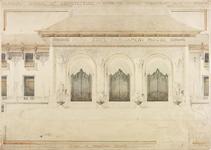Detail of principal facade.
Design for colonial parliament house
This material is held atGlasgow School of Art Archives and Collections
- Reference
- GB 1694 NMC/0322
- Dates of Creation
- 1908-1909
- Name of Creator
- Physical Description
- 1
- Digital Content
Scope and Content
Administrative / Biographical History
Alexander Thomson Scott was born on 31 August 1887 and educated at Stirling High School from 1903 to 1905. Thereafter he attended classes at the Glasgow School of Architecture and Royal Technical College under Eugène Bourdon, Alexander McGibbon and Charles Gourlay. During the period of his studies he spent two years in the office of Alexander Nisbet Paterson, from 1906 to 1908. He received his diploma in 1911 and spent the remainder of that year travelling in Italy, subsequently pursuing a postgraduate course at the School. In 1912 he moved to London where he joined James Miller as second assistant, leaving him the following year to work for the landscape architect Thomas Hayton Mawson on the city planning of Athens, Calgary and Banff, and moving again a year later to the office of Sir Herbert Baker. He left Baker's practice for military service soon afterwards, on the outbreak of the First World War, but returned in 1918 and was promoted to chief assistant in 1922. In 1929 Scott and Baker entered a working partnership, although the firm's name did not become Sir Herbert Baker & A T Scott until 1931. Scott had been admitted FRIBA on 3 November of the intervening year, his proposers being Baker, Francis William Troup and Thomas Smith Tait; his nomination papers note that he had made a return trip to Italy by that point, as well as travelling in Spain and visiting New York once and India twice on Baker's business, collaborating with Baker on the government buildings in Delhi and on bank buildings in South Africa. When Baker died in 1946 Scott went into partnership with Vernon Helbing, remaining in practice with him until his death in 1962.
Note
Alexander Thomson Scott was born on 31 August 1887 and educated at Stirling High School from 1903 to 1905. Thereafter he attended classes at the Glasgow School of Architecture and Royal Technical College under Eugène Bourdon, Alexander McGibbon and Charles Gourlay. During the period of his studies he spent two years in the office of Alexander Nisbet Paterson, from 1906 to 1908. He received his diploma in 1911 and spent the remainder of that year travelling in Italy, subsequently pursuing a postgraduate course at the School. In 1912 he moved to London where he joined James Miller as second assistant, leaving him the following year to work for the landscape architect Thomas Hayton Mawson on the city planning of Athens, Calgary and Banff, and moving again a year later to the office of Sir Herbert Baker. He left Baker's practice for military service soon afterwards, on the outbreak of the First World War, but returned in 1918 and was promoted to chief assistant in 1922. In 1929 Scott and Baker entered a working partnership, although the firm's name did not become Sir Herbert Baker & A T Scott until 1931. Scott had been admitted FRIBA on 3 November of the intervening year, his proposers being Baker, Francis William Troup and Thomas Smith Tait; his nomination papers note that he had made a return trip to Italy by that point, as well as travelling in Spain and visiting New York once and India twice on Baker's business, collaborating with Baker on the government buildings in Delhi and on bank buildings in South Africa. When Baker died in 1946 Scott went into partnership with Vernon Helbing, remaining in practice with him until his death in 1962.
Physical Characteristics and/or Technical Requirements
pencil, ink and watercolour on paper
Dimensions: 552 x 775 mm
Additional Information
Published

